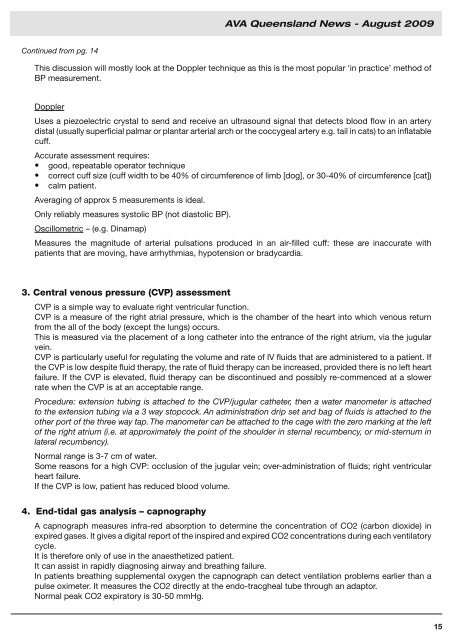Queensland News - Australian Veterinary Association
Queensland News - Australian Veterinary Association
Queensland News - Australian Veterinary Association
- No tags were found...
You also want an ePaper? Increase the reach of your titles
YUMPU automatically turns print PDFs into web optimized ePapers that Google loves.
AVA <strong>Queensland</strong> <strong>News</strong> - August 2009Continued from pg. 14This discussion will mostly look at the Doppler technique as this is the most popular ‘in practice’ method ofBP measurement.DopplerUses a piezoelectric crystal to send and receive an ultrasound signal that detects blood flow in an arterydistal (usually superficial palmar or plantar arterial arch or the coccygeal artery e.g. tail in cats) to an inflatablecuff.Accurate assessment requires:• good, repeatable operator technique• correct cuff size (cuff width to be 40% of circumference of limb [dog], or 30-40% of circumference [cat])• calm patient.Averaging of approx 5 measurements is ideal.Only reliably measures systolic BP (not diastolic BP).Oscillometric – (e.g. Dinamap)Measures the magnitude of arterial pulsations produced in an air-filled cuff: these are inaccurate withpatients that are moving, have arrhythmias, hypotension or bradycardia.3. Central venous pressure (CVP) assessmentCVP is a simple way to evaluate right ventricular function.CVP is a measure of the right atrial pressure, which is the chamber of the heart into which venous returnfrom the all of the body (except the lungs) occurs.This is measured via the placement of a long catheter into the entrance of the right atrium, via the jugularvein.CVP is particularly useful for regulating the volume and rate of IV fluids that are administered to a patient. Ifthe CVP is low despite fluid therapy, the rate of fluid therapy can be increased, provided there is no left heartfailure. If the CVP is elevated, fluid therapy can be discontinued and possibly re-commenced at a slowerrate when the CVP is at an acceptable range.Procedure: extension tubing is attached to the CVP/jugular catheter, then a water manometer is attachedto the extension tubing via a 3 way stopcock. An administration drip set and bag of fluids is attached to theother port of the three way tap. The manometer can be attached to the cage with the zero marking at the leftof the right atrium (i.e. at approximately the point of the shoulder in sternal recumbency, or mid-sternum inlateral recumbency).Normal range is 3-7 cm of water.Some reasons for a high CVP: occlusion of the jugular vein; over-administration of fluids; right ventricularheart failure.If the CVP is low, patient has reduced blood volume.4. End-tidal gas analysis – capnographyA capnograph measures infra-red absorption to determine the concentration of CO2 (carbon dioxide) inexpired gases. It gives a digital report of the inspired and expired CO2 concentrations during each ventilatorycycle.It is therefore only of use in the anaesthetized patient.It can assist in rapidly diagnosing airway and breathing failure.In patients breathing supplemental oxygen the capnograph can detect ventilation problems earlier than apulse oximeter. It measures the CO2 directly at the endo-tracgheal tube through an adaptor.Normal peak CO2 expiratory is 30-50 mmHg.15
















